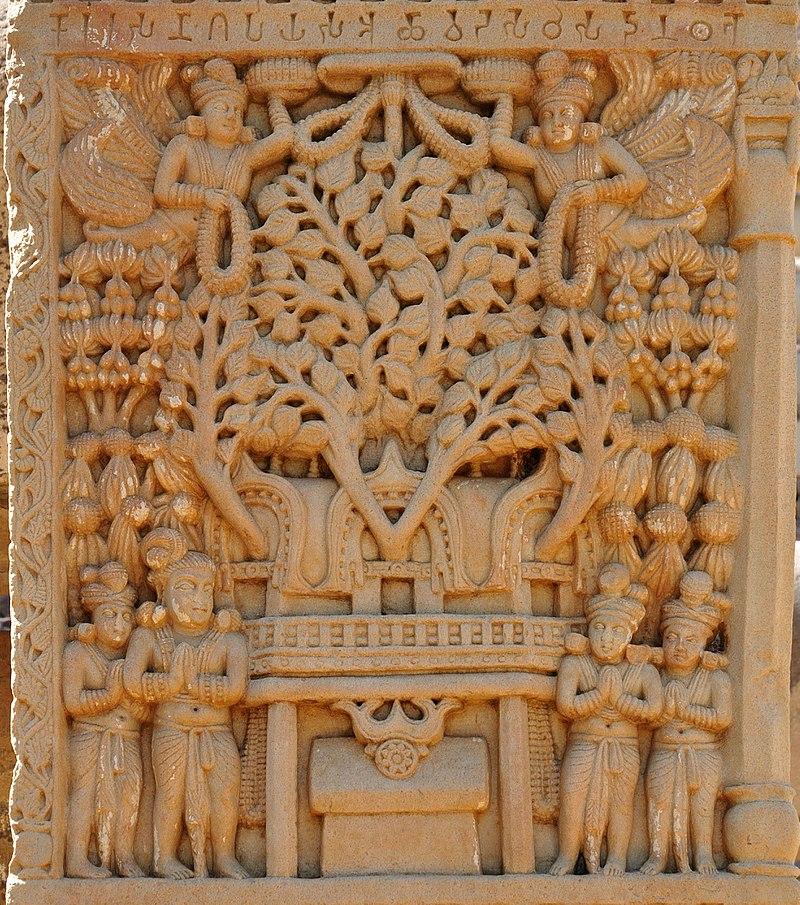
A replica of the iconic eastern torana or gateway to the Great Stupa of the ancient Sanchi Buddhist complex in central India was recently unveiled in Berlin. Standing in front of the Humboldt Forum, part of a museum complex dedicated to human history, art, and culture.
Standing 10 meters high, six meters wide, and weighing in at 150 tonnes, work on the pink sandstone reproduction began in November at a cost of 1.6 million euros (US$1.7 million). According to media reports, expert sculptors from Germany and India worked together on the intricate relief-work, which depicts episodes from the Jatakas, tales of the life of the Buddha, on the three crossbeams and two pillars. The landmark is also decorated with Buddhist symbols and detailed representations of elephants, lions, peacocks, and other beings.
India’s ambassador to Berlin, Harish Parvathaneni praised the Humboldt Forum’s initiative “to place the replica of the Sanchi Gate in the heart of Berlin,” noting that the new landmark was deserving of recognition as it “embodies Buddha’s message of peace, compassion and love for all living beings.” (DW)
Located directly in front of the Berlin Palace, which houses the Ethnological Museum and the Museum of Asian Art in the Humboldt Forum, there are plans to add a bronze model of the Great Stupa beside the torana, to provide additional historical context for the reproduction and to serve as a tactile model for the visually impaired. The original monument in India, more than 2,000 years old, has been a listed UNESCO World Heritage Site since 1989.

From wikipedia.org
“I am very excited about the replica of the East Gate of the Sanctuary of Sanchi in front of the Humboldt Forum,” the museum’s general director Hartmut Dorgerloh said in a press statement. “As an exciting counterpoint to the baroque facades, what visitors can look forward to inside the building will now also be visible in front of the portals of the Humboldt Forum: The diversity of the world in the center of Berlin.” (DW)
The original Sanchi Buddhist complex sits on a hilltop in the central Indian state of Madhya Pradesh, some 46 kilometers from the state capital, Bhopal. The site is composed of a series of stupas, temples, pillars, and other structures, variously constructed between the third century BCE and the 12th century CE.
The central structure, the famed Great Stupa, is one of the oldest stone structures in India and a significant monument to early Buddhism, commissioned by the Mauryan emperor Ashoka in the third century BCE. The hemispherical brick structure enshrining sacred relics of the Buddha is more than 16 meters high and 36 meters in diameter, and is flanked by four elaborately carved torana gateways marking the cardinal directions, and said to represent courage, love, peace, and trust.
Ambassador Parvathaneni observed that the Sanchi torana now stands in the east of Berlin as a counterpart to the Brandenburg Gate in the west, and as a beautiful symbol of the connection between East and West, complementing the Buddha’s message conveyed in the imagery carved on the gate: that of peace and understanding, and of the peoples of the world as one family.
See more
India’s ancient Buddhist gate has new replica in Berlin (DW)
Neu am Humboldt-Forum: Das indische Sanchi-Tor als Werbeträger und Weltversöhner (Berliner Zeitung)
Replik von altindischem Tor vor Humboldt Forum fertig (Stern)
Vor dem Humboldt Forum entsteht ein buddhistisches Heiligtum (BZ)
Related news reports from BDG
Ancient Buddhist Structures and Murals Discovered in Madhya Pradesh, India
Three New Caves Discovered at Ancient Buddhist Site Near Nashik, India
Archaeologists in India Discover Earliest Known Female-Led Monastery
Buddhist Heritage Sites Still Neglected in India’s Andhra Pradesh
Development Threatens Ancient Buddhist Site in Southeast India, Activists Say














